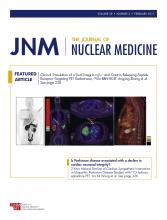REPLY: Thank you for the opportunity to respond to the letter to the editor by Pattison et al. regarding our article presenting the results of the THYROPET study (1). That study showed that after preparation with recombinant human thyroid-stimulating hormone (rh-TSH), 124I PET/CT could not predict the outcome of the posttherapy 131I scan after thyroid hormone withdrawal (THW) in patients with suspected recurrence of differentiated thyroid cancer. We discussed several factors potentially causing these disappointing results; both technical issues regarding 124I PET/CT acquisition and biologic matters were put forward.
Pattison et al. argue that the biologic explanations are most probably causing the false-negative 124I PET/CT scans. We fully agree that the difference in the method of preparation on the 124I PET/CT (after rhTSH injections) and the 131I therapy with posttherapy scanning (after THW) is a likely cause of the 124I PET/CT being false-negative. Data from ours and other studies support this hypothesis (1–3). Confirmation through prospective studies with intrapatient comparisons of rhTSH- and THW-stimulated 124I PET/CT is warranted.
Notably, the one important downside of 124I PET/CT scanning after THW as a diagnostic tool is the reduced quality of life during the period of THW (4).
Whether technical issues can be ruled out as a factor, as argued by Pattison et al., is in our opinion not definite. The sensitivity of 124I PET/CT is shown to be confined by specific scanner characteristics (e.g., no time-of-flight or point-spread function) (5). New scan protocols and new-generation scanners will—to a greater or lesser degree—improve the sensitivity of 124I PET/CT. Similarly, higher administered doses of 124I (e.g., 222 MBq as applied by Ho et al. (6)) might improve lesion detection. Currently, it is not known whether the lesions detected by the improved sensitivity of 124I PET/CT can be treated with a curative administered dose of 131I without exceeding safety limits for bone marrow. Future studies are needed to elucidate this.
In conclusion, we agree with Pattison et al. that the method of preparation on the 124I PET/CT is probably the most important factor causing false-negative 124I PET/CT findings. However, it is too early to state that it is the only factor.
Footnotes
Published online Sep. 22, 2016.
- © 2017 by the Society of Nuclear Medicine and Molecular Imaging.







